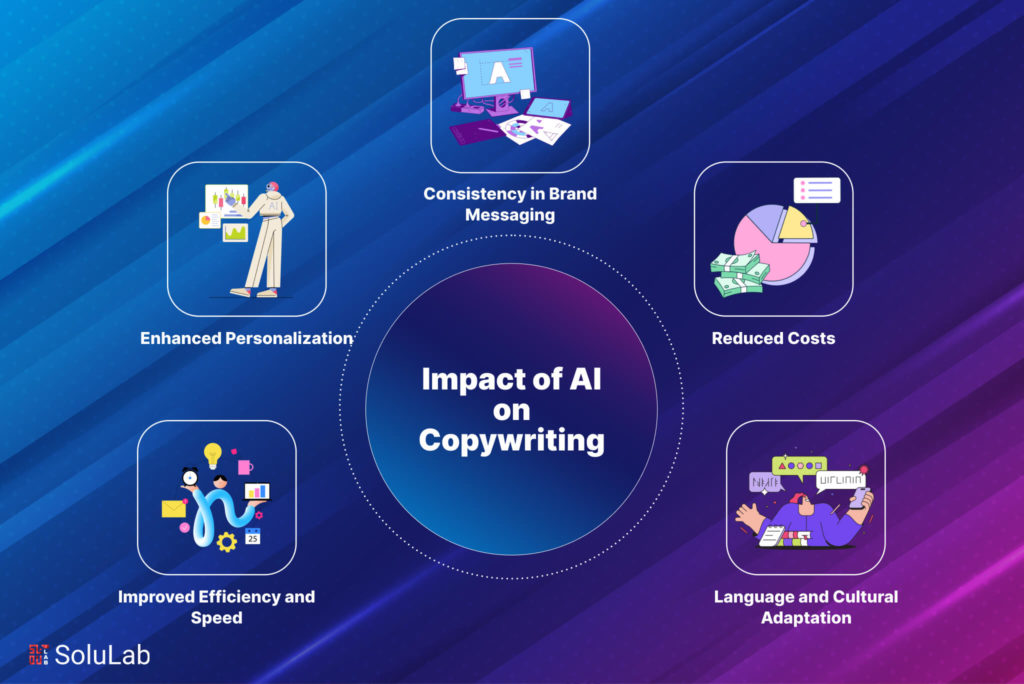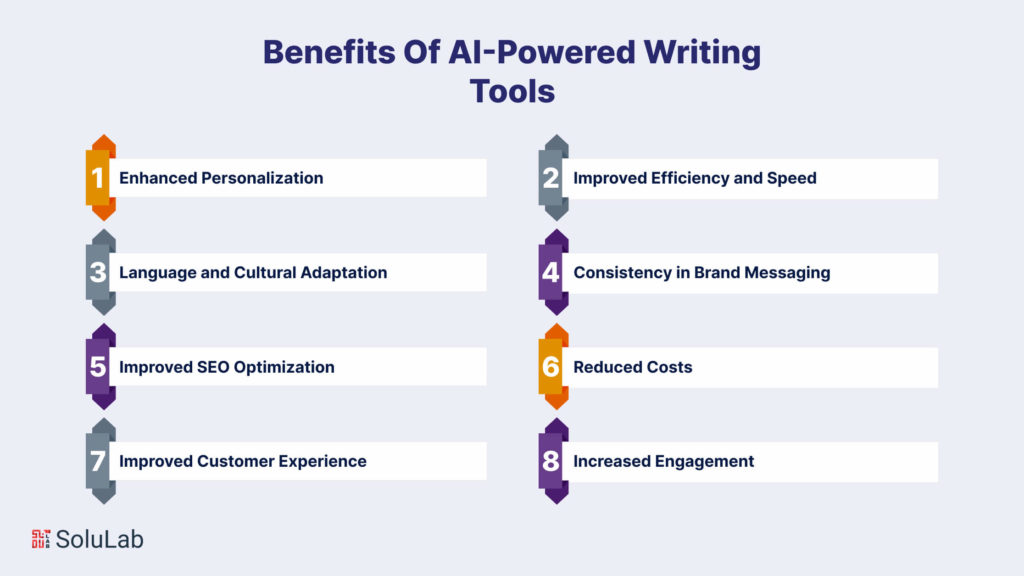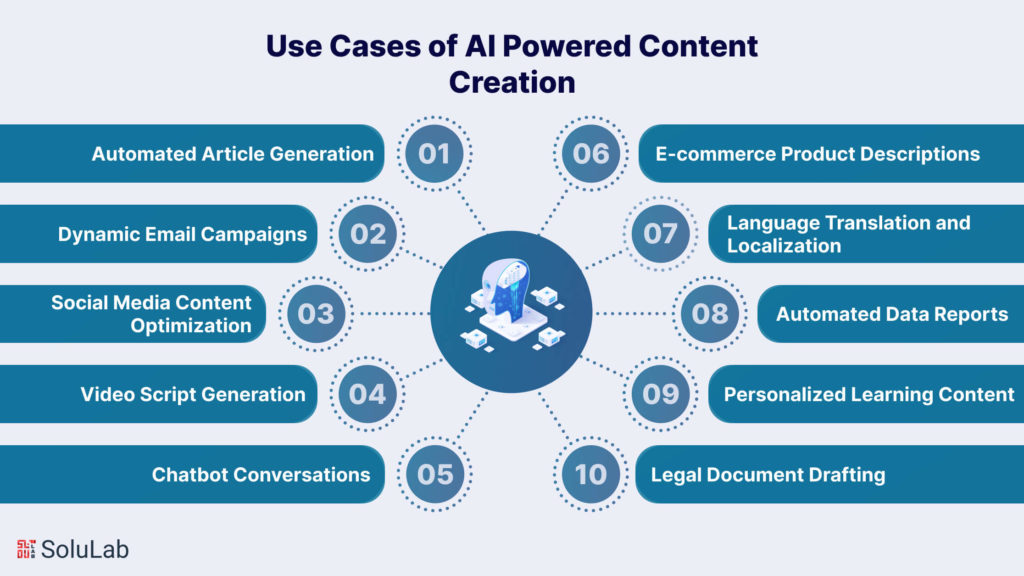
Have you ever visited a digital marketing website, only to have an eerily precise pop-up appear promoting exactly what you were searching for? Or perhaps you stumbled upon an article which seemed to speak directly to you, headline and all? If these web experiences felt a bit too personalized, you likely just encountered AI in copywriting.
AI copywriting leverages smart algorithms to generate written marketing content tailored to individual website visitors and audiences. This revolutionary technology allows brands to create vast volumes of custom digital copy at scale, in the form of product descriptions, landing pages, blog posts, social captions, and more. It works by combining comprehensive user data with predictive language models to essentially “ghostwrite” for human marketers.
The user data comes from tracking online behaviors – what people search for, click on, share, purchase from past web interactions. All this gets fed into machine learning systems which then analyze it to determine interests, preferences, communication styles. AI for content creation delivers more personalized selling experience. So how does the AI do this?
In this article we’ll talk about how AI works for content creation and how it’s changing marketing.
Understanding AI For Copywriting
Well, AI in copywriting refers to using AI technology to create content. This content can range from advertisements and product descriptions to social media posts and articles.
AI-generated copywriting can be a significant time-saver for businesses that need to produce a large volume of content quickly. By automating content creation, companies can reduce their reliance on human writers and allocate more time to creative tasks. Additionally, AI-generated copywriting excels at personalizing content for individual users, enhancing the relevance and engagement of advertising.
However, it’s important to note that AI tools for content creation are still a relatively new technology, and questions persist about its quality and ethical implications. Nevertheless, the new technology is an exciting and rapidly evolving field that has the potential to transform how we create and consume written content.
How Does The AI In Content Creation Works?
AI writing tools use smart computer programs to create text that looks like it was written by a person. They do this by using fancy algorithms, machine learning, and natural language processing.
1. Natural Language Processing (NLP): NLP is a part of computer science and artificial intelligence that focuses on helping computers understand and generate human languages. In the world of AI-generated writing, NLP is important because it teaches machines how sentences are structured, the rules of grammar, and the meanings of words or phrases in different situations.
2. Machine Learning (ML): ML is another piece of the puzzle. ML involves training computer programs on large sets of text data from various sources, like books or articles. These programs learn patterns in the data, allowing them to predict what should come next based on what they’ve seen before. This is how AI systems, such as GPT-3, can create new content that sounds like it was written by a person.
Apart from NLP and ML, AI systems also use data analysis and context understanding. They look at the information they receive, pick out what’s important, and make connections between different parts of the content. For example, if an AI is summarizing news, it needs to figure out the key points from multiple articles about a topic to create an accurate summary.
Benefits Of Using AI-Powered Writing Tools

1. Enhanced Personalization
AI-generated copywriting excels in tailoring content to individual consumers. By analyzing vast amounts of data, AI algorithms understand customer preferences, behavior, and purchase history. This enables the creation of personalized content, such as customized emails with compelling subject lines, engaging product descriptions, and persuasive calls to action. This personalization increases the likelihood of conversion and fosters customer loyalty.
2. Improved Efficiency and Speed
Using AI tools for content creation significantly reduces the time and effort required for content creation. Unlike traditional methods, AI algorithms can generate content rapidly, allowing businesses to respond quickly to market demands. This increased efficiency not only improves productivity but also enables the timely launch of targeted marketing campaigns.
3. Language and Cultural Adaptation
In a globalized world, AI-powered copywriting addresses the challenge of reaching diverse audiences. Through natural language processing and machine translation, AI algorithms create content in multiple languages, ensuring effective communication across different markets. For example, an international e-commerce platform can maintain consistent quality and tone in product descriptions for a global audience.
4. Consistency in Brand Messaging
The use of AI for content creation helps to ensure consistency in a brand’s voice and tone across various channels. Natural language processing algorithms analyze existing content to mimic a company’s unique style, fostering a cohesive brand identity. This consistency enhances the overall customer experience, building trust and loyalty with the target audience.
5. Improved SEO Optimization
AI-generated copywriting significantly contributes to SEO efforts by automatically generating well-optimized content. These tools incorporate relevant keywords and adhere to search engine guidelines, assisting businesses in creating high-ranking web pages and blog posts. By analyzing keyword trends and recommending topics, AI platforms simplify the process of generating SEO-friendly content.
6. Reduced Costs
Investing in AI-powered tools minimizes the need for additional copywriters, saving on operational costs. The scalability of these tools accommodates an organization’s growing copywriting needs without requiring additional resources.
7. Improved Customer Experience
Using AI in content creation helps to enhance the customer experience by providing quick and accurate responses to inquiries. For example, AI-powered chatbots offer instant answers without human intervention, saving time and improving customer satisfaction.
8. Increased Engagement
AI copywriting boosts customer engagement by creating more interactive content. Personalized videos and interactive quizzes encourage customers to interact with the brand, building stronger relationships and fostering loyalty.
The Role of Humans in AI Copywriting
Although AI is valuable for content creation and marketing, it’s crucial to appreciate the unique contribution of human input. Human writers bring creativity and empathy, crucial for genuinely connecting with an audience.
While AI excels at generating content based on data and patterns, it falls short in replicating the personal touch of human writing.
In practice, writers should collaborate with the best AI for content creation, treating it as a helpful tool in the writing process rather than depending on it exclusively. This partnership ensures a blend of AI efficiency with the nuanced, human touch in crafting compelling content.
Tips for Using AI to Enhance Content Creation
1. Define Clear Objectives
Clearly outline your content goals and share this information with the AI tool. Providing a clear objective helps the algorithms generate content that aligns precisely with your intended outcomes.
2. Pick the right tool
Numerous AI writing tools are available, each with its own strengths and weaknesses. Some are great for email marketing, while others work better for product descriptions or social media posts. Research to find a tool that fits your specific needs.
3. Collaborate with AI
Consider AI as a collaborative partner rather than a replacement for human input. Use the generated content as a foundation and infuse it with your unique voice and insights. This approach ensures a more personalized and audience-tailored final product.
4. Experiment and Iterate
Embrace experimentation by trying out various AI tools, templates, and frameworks. This exploration allows you to discover new possibilities and continuously enhance your content creation process.
5. Measure and Analyze
Regularly track the performance of AI-generated content and analyze the gathered data. Understand what resonates best with your audience, and use this valuable feedback to refine and optimize your content strategy over time.
6. Include human input
While AI-generated writing is a valuable tool, it’s not a substitute for human creativity and insight. Make sure to involve human input in your content creation process, whether through editing, quality control, or other methods.
Future Trends in AI Copywriting
AI is a big deal, but content marketers have only just started using it in recent years. As technology gets better, it’s going to change how we create, improve, and personalize content in ways we can’t even think of yet.
If you want to make sure your content strategy stays good in the future, keep an eye on new AI technologies and try out new tools when they come out. Look forward to things like:
- Cool interactive content: Imagine content that feels real and interactive, using things like augmented reality (AR) and virtual reality (VR). Creative teams might even create their own special AI tools.
- Smarter predictions and suggestions: Picture analytics and suggestion tools that understand what users are doing right now. They’ll give super personalized content journeys based on what each person likes and wants.
- AI chatbots that talk like people: Think about chatbots that are super smart and can have real conversations. They’ll understand feelings and suggest content like a helpful virtual assistant. Using these in how you talk to customers will be really important.
- Helpful content workflows: Envision workflows that use AI to do boring tasks automatically. They’ll also make content better based on how well it’s doing. This way, people can focus more on big plans and being creative. So, the future of making content is teamwork between AI and humans.
AI-Powered Content Creation: Use Cases

1. Automated Article Generation
Analyze data, trends, and user preferences to create engaging and relevant articles at scale, reducing manual effort and time for content creators while ensuring content is tailored to target audiences.
2. Dynamic Email Campaigns
AI enables personalized and dynamic email content creation by analyzing recipient behavior and preferences. This ensures higher engagement and conversion rates as emails are tailored to individual interests, improving overall marketing effectiveness.
3. Social Media Content Optimization
Use AI-driven content creation tools to analyze social media trends, user interactions, and historical data for generating compelling and shareable content. This ensures brands stay relevant and maintain an active presence across various platforms.
Read Our Blog: AI in Social Media
4. Video Script Generation
Analyze diverse sources to create engaging video scripts with AI. This streamlines the video production process, ensuring content aligns with current trends and audience preferences, resulting in more compelling and impactful videos.
5. Chatbot Conversations
AI-driven chatbots leverage natural language processing to understand user queries and generate appropriate responses. This enhances customer engagement by providing instant, accurate, and personalized information, improving overall user experience.
6. E-commerce Product Descriptions
Create product descriptions by analyzing features, reviews, and market trends. This automates the creation of compelling and informative product content, helping businesses save time and resources while maintaining a consistent and appealing brand voice.
7. Language Translation and Localization
AI-powered content creation tools facilitate seamless translation and localization of content across languages. This ensures global audiences receive content that is culturally sensitive, linguistically accurate, and contextually relevant.
8. Automated Data Reports
Automate the generation of data-driven reports by analyzing large datasets using AI. This helps businesses quickly derive insights, make informed decisions, and present complex information in a comprehensible manner, streamlining the reporting process.
9. Personalized Learning Content
Create educational content based on individual learning styles, progress, and preferences using AI. This enhances the effectiveness of online learning platforms by providing customized lessons and assessments, promoting a more engaging and adaptive learning experience.
10. Legal Document Drafting
AI assists legal professionals by automating the drafting of legal documents. It analyzes case law, precedents, and relevant statutes to generate accurate and contextually appropriate legal content, improving efficiency and reducing the risk of errors in legal documentation.
Successful Case Studies Of AI Use in CopyWriting
Here are some examples of how businesses have successfully used AI-generated copywriting in their advertising:
1. The North Face: They used an AI-powered chatbot on Facebook Messenger to help customers find the right jacket. The chatbot understood customer preferences and provided personalized product recommendations.
2. Alibaba: The Chinese e-commerce giant employed an AI-powered tool to create product descriptions on its online marketplace. The tool analyzed product features and benefits to generate engaging descriptions, aiding customers in making purchasing decisions.
3. JPMorgan Chase: The financial services company utilized AI tools for content creation to craft personalized ads. By analyzing customer data, the system created targeted ads based on individual interests and preferences.
4. BMW: The German automaker employed AI to produce short films promoting its new X1 model. The system analyzed car features, performance data, and target audience preferences to generate scripts used in the final films.
5. L’Oreal: The beauty products company used AI to suggest personalized hair colors to customers. The tool analyzed customer photos using computer vision, recommending hair colors that would likely complement their skin tones and features.
These examples showcase the diverse applications of AI-generated copywriting in advertising. By creating tailored and engaging content, businesses can better connect with their audiences, resulting in increased sales and engagement. As AI technology advances, we can anticipate even more innovative uses of AI-generated copywriting in the future.
Top 10 AI Copywriting Tools for 2025 Simplified
Here are the top 10 AI tools for content creation in 2024, each offering unique features to simplify and enhance the content creation process.
1. Pepper AI
Pepper AI, developed by Pepper Content, stands out as a comprehensive tool within the content marketing landscape. Unlike generic AI solutions, Pepper AI is tailored to the specific needs of content marketers. It seamlessly integrates into the content marketing workflow, offering templates curated by experts and personalized inputs based on external data sources like company websites.
2. Copy.ai
With over 500,000 users, Copy.ai is a popular AI copywriting tool utilizing GPT-3 technology. It caters to diverse content needs, generating content for ads, product descriptions, blog posts, and more. The tool provides a user-friendly interface, various templates, a built-in editor for customization, and even includes a plagiarism checker to ensure content uniqueness.
3. Jasper
Jasper is a cutting-edge AI copywriting tool that excels in creating engaging and persuasive content quickly. Using natural language generation (NLG) technology, Jasper offers access to over 50 templates for emails, landing pages, ads, and social media. It also integrates with Grammarly and Surfer for SEO content creation, providing diverse tone and style options.
4. Copysmith
Widely used by businesses and individuals globally, Copysmith is a versatile AI copywriting tool. Its flexible pricing plans, including a free trial, cater to various budgets. Copysmith stands out with its capability to generate content for different industries, a smart campaign builder, and features for collaboration and workflow management.
5. Closers Copy
Closers Copy specializes in crafting high-converting sales copy using natural language processing technology. It tailors content to the target audience, offering templates for different stages of the sales funnel. The tool also includes a performance tracking feature to measure the effectiveness of the generated copy.
6. Writesonic
Harnessing GPT-3 technology, Writesonic is a popular copywriting AI tool for creating compelling content. It covers a wide range of content types, including blog posts, product descriptions, and social media posts. The tool provides templates, a built-in editor for customization, and features for research and team collaboration.
7. Rytr
With over 850,000 users, Rytr is a widely adopted AI copywriting tool that caters to writers, marketers, and businesses. Offering flexible pricing plans, Rytr generates content for blog posts, product descriptions, and social media. The tool includes an AI-enabled chatbot, Chatsonic, a built-in editor, and integration with Surfer SEO for creating SEO-friendly content.
8. Wordtune
For those looking to enhance the clarity and impact of their writing, Wordtune is an ideal AI copywriting tool. It offers real-time rewriting and improvement of existing text, along with integrations with popular platforms like Gmail, Google Docs, Slack, Twitter, and Microsoft Word. The tool also includes a built-in dictionary and a plagiarism checker.
9. Anyword
Specializing in creating high-converting ad copy, Anyword is a favored tool for businesses and marketers. It supports various platforms, including Google Ads, Facebook, and Instagram. Anyword enables customization of content based on specific requirements, allowing users to tweak tone, style, and length. The tool facilitates A/B testing to determine the most effective copy.
10. Writecream
Writecream is a versatile AI-powered writing tool designed to streamline content creation. Users can assign tasks to ChatGenie, which can generate copy for blog posts, Facebook ads, and more. The tool also offers additional features such as human-sounding voiceovers, tools for crafting investment pitches, and cold emails. Writecream supports multiple browsers, including Opera, Google Chrome, and Microsoft Edge.
Take Away
AI copywriting tools are changing how businesses make and share content. These tools use smart technology to understand a business’s products, services, and who they’re trying to reach. With this info, the tools can make personalized and interesting content that connects with customers. This tech has many uses, like making special product descriptions or creating ads that are just right for the audience.
But there are things to think about, like being fair and clear with this technology. Sometimes, these tools might have biases or things that are not clear. Even with these challenges, businesses that use AI for content creation can get ahead in a busy market. By using this tech to make content that’s both interesting and personal, businesses can talk to their customers in cool and new ways.
FAQs
1. What is AI copywriting?
AI copywriting uses Artificial Intelligence tools to make written content. It uses special programs that can study data and language to write things like ads or social media posts.
2. How does AI copywriting work?
First, the AI gets information to use, like details about a business and who they want to reach. Using this, the AI studies language and writing styles to make content that connects with the target audience.
3. Can AI copywriting completely replace human writers?
Not yet. AI in copywriting can help write faster and provide ideas. But it still needs human input and editing. AI doesn’t have human judgment, common sense and creativity.
4. What types of copy can AI generate?
AI can help generate all types – website pages, blogs, social media, ads, product descriptions and more. But complex stories or emotional appeals may be beyond current AI.
5. How do I use AI copywriting in my business?
Add an AI assistant to your team to expand capacity. Give it brand guidelines, target demographics and topics to cover. Generate AI drafts then have people review, edit if needed, and approve content.
6. Is AI-written content plagiarized?
It shouldn’t be if the AI is well-designed. AI studies data to learn patterns but generates new combinations of words and phrases. Some AI checks drafts against existing content to avoid duplication. But always double-check.
7. What industries use AI copywriting the most?
AI copywriting is often used in marketing, advertising, e-commerce, and media/publishing. It helps quickly produce high volumes of customized content.
8. How good is AI at writing emotionally appealing copy?
Current AI struggles to make truly emotional connections. It can mimic formats that grab attention but lack human understanding of subtle emotions. Combining AI ideas with human creativity works best for now.






